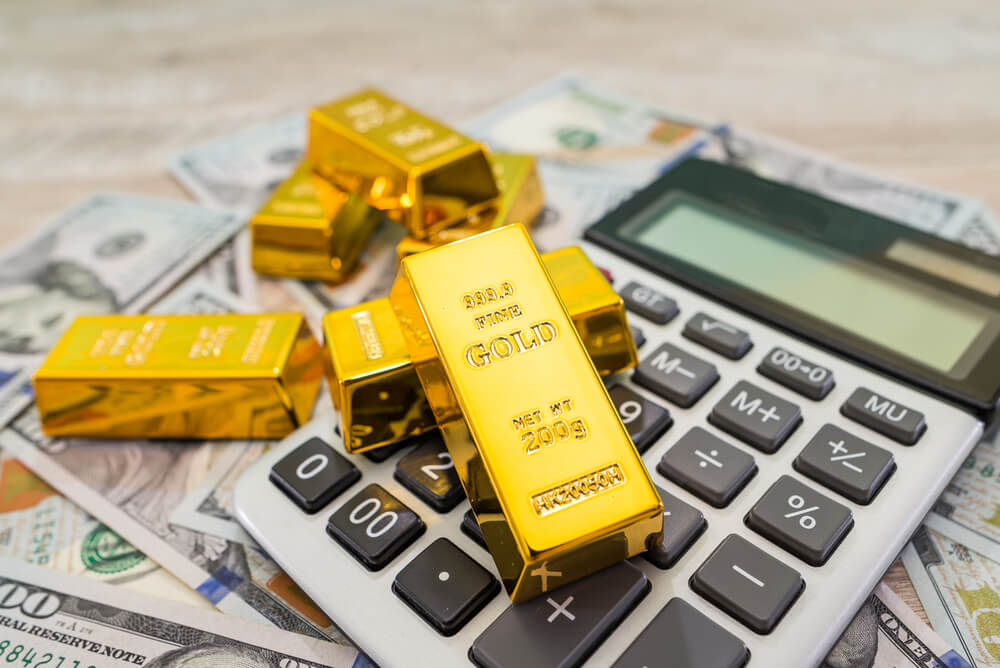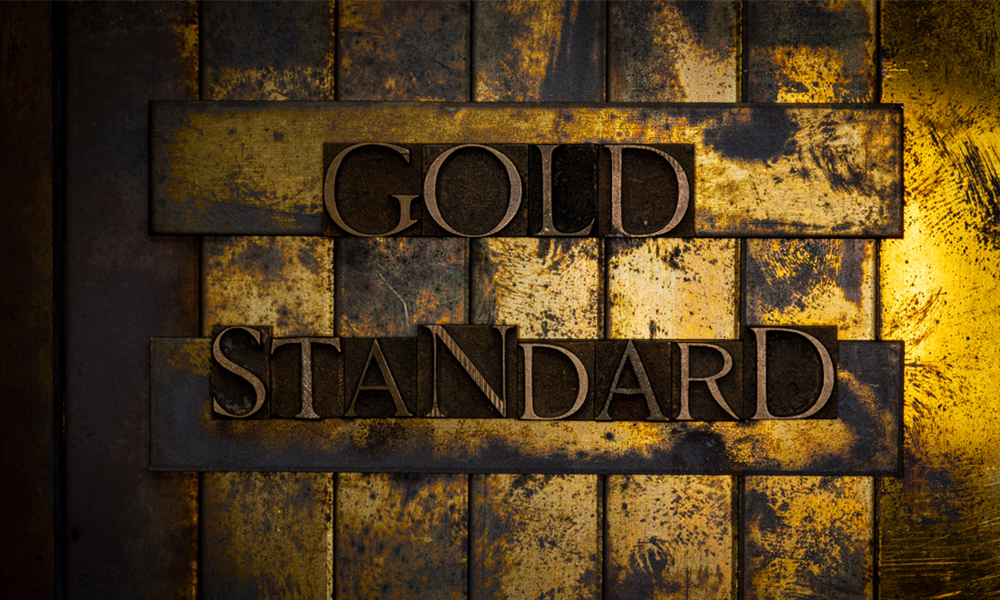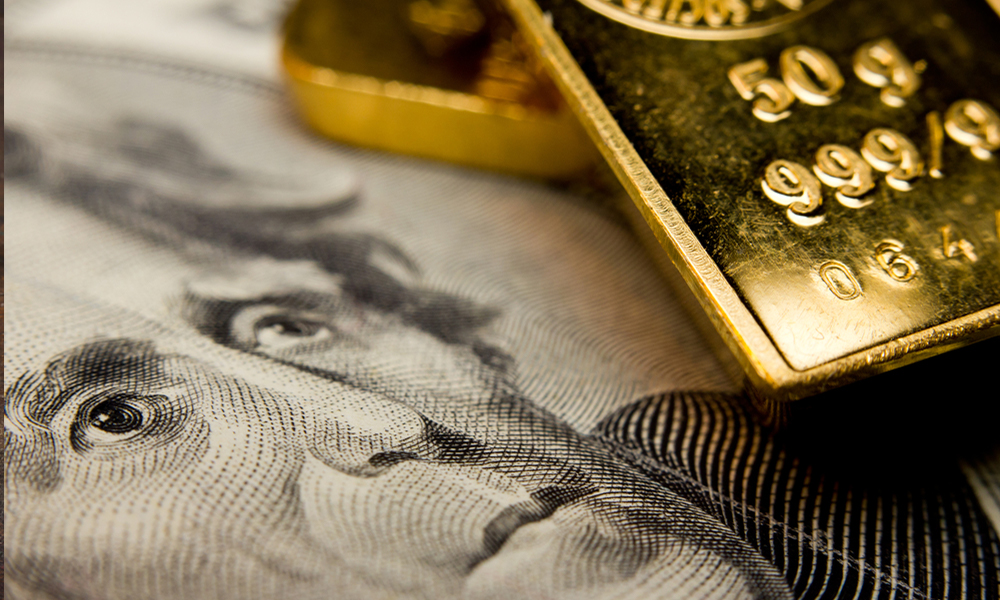
What is the Gold Standard?
Paper currency is just that — paper, with an intrinsic value amounting to naught. Fiat money needs some sort of support for it to assume value. The federal government backs the American dollar, for instance.
Gold has been used, in the past, to set money’s value — under the “gold standard” arrangement. Silver backed up paper currency before that. There was also the bimetallic standard (both gold and silver used to back money). But no precious metal or commodity has had a storied relationship with paper currency as gold has.

So, what is the “gold standard”? Why was it instituted in the first place? Why is the gold standard system not relevant anymore? Read on to find out.
This article would walk you through/give you (in tremendous detail):
- A brief overview of the gold standard; its working mechanism; positives and negatives
- The adoption of the system; what preceded and succeeded it
- The eventual demise of the system and the alternative(s)
- The possibilities of the monetary standard making a coming back, and more.
If you ever needed a complete history lesson about the gold standard, here it is. Read on to learn all possible aspects of the system.
Table of Contents
Gold Standard: A Detailed Overview
The term “gold standard” denotes the erstwhile gold-backed monetary policy — unlike fiat money that is not looked after by a commodity (tangible or non-tangible). In simpler terms, governments printed paper money equivalent to their gold reserves under the system.
Governments that adhered to the standard could only borrow or raise money against their gold reserves. They could not print money at will to clear debts, fund initiatives, or anything. If a state printed cash above or not per its reserves, it risked causing an economic crisis or hyperinflation — thanks to the crushed faith in its currency.
The gold standard seized a lot of money supply power away from the central bank, basically rendering them unnecessary or redundant. During most of that time, the classical gold standard was in place, America did not have a proper or actual central bank. It was only in 1913 that the U.S. saw its first existing central bank, in the form of the Federal Reserve System.
Countries that employed the gold-backed monetary setup secured the price of gold and purchased and sold the metal at a fixed price. That price determined the currency’s actual worth. For instance, if a nation set gold prices at $450 per ounce, its currency’s value would have been 1/450th of a gold ounce. The money in circulation during the period wasn’t gold, but it promised to pay gold.
The gold standard helped ascertain how a country’s currency stacked against another nation, giving rise to the “gold exchange standard”. Since the standard maintained fixed gold prices, the exchange rates between currencies appended to gold were secured in the foreign exchange markets.
If a country sets the price of gold at a particular value and another country chooses to select a different fixed price for its gold, the exchange value of the two currencies would be ascertained accordingly. The fixed exchange rate caused price levels across the globe to move in synchronization with each other.
Read more: How Much Does Gold Grading Cost
The Positives and Negatives of the Gold Standard
The gold-backed monetary system was in effect for several decades. It couldn’t have survived for so long if it didn’t have inherent goodness. Here are some of the positive attributes that advocates of the system like to highlight:
Checked Inflation
The gold standard curbed reckless paper money printing — discouraging inflation and debt as a result. From 1880 to 1914, the classical gold standard phase in the States, inflation was just 0.1 percent a year on average. During the seemingly tumultuous gold standard decade (1894 to 1904), the average inflation rate was 0.36.
Accorded Money an Inherent Value
Gold, like other valuable metals and commodities, has inherent value. Any currency directly linked to the yellow metal would automatically assume the same intrinsic value too.
With fiat money, there’s no such innate monetary significance. If central banks print money uncontrollably, it will lead to hyperinflation. In other words, fiat currency would dramatically erode in value.
Hyperinflation is out of the question if a metal like gold backs money or the money supply is determined by gold availability.
But not all’s merry with the gold standard — certainly not! There are quite a few things that have caused problems. The following are some of the drawbacks of the gold standard:
The Dependency Was Constricting
Gold is scarce, and not every country has equitable access to the metal. If a government can only print money based on the gold reserves it has, that’s pretty constraining. Nations without gold would not just be at a disadvantage, but they’ll also have the perpetual need to scamper for gold to boost their gold reserve and stay economically relevant.
Not to mention, finding new gold is time-, resource-, and cost-intensive. Maintaining a complete gold coin standard was more significant than 2.5 percent of America’s gross national product (GNP) in 1960. Though gold mining is carried out on every continent, not every swathe of terra firma has an equal amount of gold underneath.
Sent Monetary Shock Waves
In 1848, when new gold was discovered in California, America’s money supply increased. The monetary shock spiked domestic expenditures, price levels, and nominal income. The price level rise made American exports more expensive, setting off a shortfall in the United States’ balance of payments.
And since the gold standard affords central banks little discretion concerning monetary policies, the respective economies were less able to offset or avoid the economic shocks.
Deflationary and Increased Unemployment Rates
While the gold standard was reasonably successful at arresting inflation, it was deflationary on the other hand. Limited gold reserves and the accompanying lack of money supply meant stifled economic growth. And when there’s financial instability, political unrest follows.
Deflation, in the short term, seems beneficial. Consumers experience a sudden increase in their purchasing power, which lets them spend little than usual and save more money. The falling prices also contribute to debt reductions as people are more eager to sell assets before assets’ values plummet further.
In the long term, however, things look bleak.
The declining prices start to hurt businesses. Companies lay off workers and cut salaries. That leads to increased unemployment, a decline in consumer confidence, and falling incomes. The declining revenues and lowered confidence push companies to cut their product prices, spawning a vicious cycle.
All through the gold standard period, unemployment was at its peak level. From 1879 to 1913, unemployment was 6.8 percent on average in the United States. Between the years 1946 and 2003, it was 5.9 percent.
Ravaged the “Working Class”
Economic success during the classical gold standard period didn’t come by easily. The data may present a rosy picture, but it didn’t provide all the details one would need to comprehend its real impact truly.
For more than a handful of Americans, the effects of the gold standard were destructive. During the 1870s, after the United States embraced the gold standard, the prices of agricultural goods fell continuously for close to two decades. American farmers found themselves under debt mountains.
According to several economists, the Great Depression wouldn’t have been as bad if not for the gold standard. Most countries that took more time to abandon the gold-backed monetary policy, such as the United States and France, suffered the most due to the global economic depression.
The Gold Standard Adoption

Now that you have a brief understanding of the gold standard, let’s learn how it all started.
In 1717, England adopted a de facto (unofficial) gold standard. The country formally adopted it in 1821. Its meteoric rise in production and world trade brought about significant gold discoveries, helping the monetary standard hold its own for more than a century.
The United States adopted a de facto gold standard in 1834. From 1834 to 1933, America fixed its gold price at $20.67 an ounce. The price of gold didn’t go up or fall during the entire period. In 1900, America embraced the gold standard de jure (legally) after Congress passed the Gold Standard Act. The Act recognized gold as the lone metal to redeem paper currency.
The Act was essentially a guarantee that the state would convert any sum of fiat currency for its worth in gold. That meant commercial transactions no longer depended on gold bullion or gold coins as paper and coin currency had a promised value attached to a tangible thing.
Other major nations adopted the gold-based monetary policy during the 1870s. The 1871 to 1914 period is considered when the international gold standard was truly in existence and thriving. It denoted a period during which the global environment was relatively peaceful, and the gold supply was healthy.
Precursor(s) to the International Gold Standard
During prehistoric times, expensive metals and other valuable commodities were used as a country’s currency. The earliest known usage of gold coins was in Lydia (present-day Turkey) during 600 B.C. Gold coins were minted because it wasn’t easy or convenient to ascertain the weight of gold each time before people could make a transaction.
Before gold could be used to back currency, the silver standard existed. Silver was first used as a currency measure during the ancient Greek periods. After the Roman Empire fell, silver coins were widely used, with countries such as China, Great Britain, India, Bohemia, and the U.S. adopting them.
The silver standard allowed paper money conversion into silver units at a fixed rate. There was also the bimetallic standard that facilitated the conversion of currency into gold or silver. During the bimetallic standard era, silver coins were favored over gold coins.
However, when America adjusted the silver-to-gold ratio price in 1834 from 15:1 to 16:1, the move caused an upward surge in silver exports, resulting in silver coins pretty much disappearing from U.S. shores. Gold became the main form of currency in the aftermath of the event. The silver standard was officially ended in 1935 after Hong Kong and China abandoned it.
The End of the Gold Standard
The United States relinquished the gold standard in 1933. The British ditched the monetary system a couple of years ago, in 1931. Though the gold standard was officially abandoned during the 1930s, other countries washed their hands off the monetary policy unofficially much earlier. It took some time before America completely wiped off the traces of the contentious gold-based financial system in the early 1970s.
The First World War Brought the Curtains Down
Until 1914, countries were doing quite well with the gold standard system in place. Things, however, completely changed for good in 1914.
When the First World War (1914 to 1918) broke out, America and Europe halted the gold standard to print sufficient money for their military expenditures. After the war and having become familiarized with not relying on the gold standard, most countries did not feel the need or were scrambling to append their currencies to gold anymore. As a result, countries started to ditch the gold standard during the early 1930s.
Pre-World War I, the classical gold standard was at the core of international trade. Business or commercial transactions between countries were done with physical gold, such as gold coins. With the gold standard dropped, countries started to print a lot more money, causing a rise in inflation, but also propelling economic growth.
Also, the overvaluation of several vital currencies, such as the British pound, and the fall of imperialism in Britain meant the gold standard couldn’t deliver the stability it once provided.
The Creation of the Federal Reserve
The Federal Reserve was set up in 1913 to offer the U.S. a more flexible, more stable, and safer financial and monetary system. It started as a mesh of different regional banks governed by local business individuals and bankers. Contrary to general perception, the creation of the Federal Reserve System had little to no influence on the gold standard’s demise.
The Federal Reserve Bank functioned under the gold standard for close to two decades. Central banks and metallic standards, such as the gold standard, complement each other. Historically, central bankers, like the Federal Reserve, helped gold standards function.
The Federal Reserve was set up to remedy the banking concerns that existed before its establishment. The bank provided more borrowing power to existing banks during financial crunch periods. Second, it gave birth to Federal Reserve notes that could be minted according to existing cashflow requirements.
However, the Federal Reserve Bank couldn’t do a lot to help ailing banks meet their patrons’ demands for money. The central bank’s inability could be tied to the gold standard since the latter prevented the Federal Reserve from generating money at will to meet the cash demand.
The Bretton Woods Accord
The Bretton Woods system is an international monetary system. Set up after World War II in July 1944, the arrangement draws from the lessons learned from the Great Depression and previous gold standard systems to provide for post-war rebuilding.
The system also sought to iron out the rigidities of prior global financial systems and the little to no cooperation between countries on different monetary policies. The envisioned goal was to ensure the stability of exchange rates, mitigate competitive devaluations, and foster economic growth.
The Bretton Woods system necessitated currencies to be pegged to the American dollar, which was coupled with the gold price. Dissimilar to the classical gold standard, the Bretton Woods setup afforded the central banks of participating countries (44 in total) a lot more freedom with bolstering their economies (whenever the need arose).
The Bretton Woods System doesn’t exist anymore (dissolved during the 1970s). But, the three major institutions it created — the World Bank, the IMF (International Monetary Fund), and the WTO (World Trade Organization) — are still going strong.
The Gold Standard Alternative

Fiat or coin money replaced the gold standard. It became legal tender. With the fiat system, the money supply is entirely contingent on the decisions of the respective economies.
Fiat currencies are monies printed per the order of a government or central bank and not the gold reserves or any other form of financial reserve. The various currencies across the globe — including the dollar, pound, euro, yen, and dinar — are national currencies or legal tender. The word “fiat” is based on the Latin term “fieri”, which means arbitrary decree or act.
In the U.S., the federal government backs the paper currency. Unlike during the gold standard period, the state’s complete faith and credit supported the printed money. Though the money cannot be converted officially into or valued in gold and silver coins, one could use it to obtain gold, silver, and other prized metals — like any other commodity.
Fiat currency has stood the test of time and stays relevant even today since it blends in well into the complex framework of the modern financial world.
Paper Money Supply Before the Gold Standard
Contrary to general perception, paper currency was not first introduced after the end of the gold standard. Before gold-backed paper money became a thing in the U.S., fiat money with zero backing or convertibility to gold, silver, or any other precious metal or commodity existed. But because the move was radical for the time (1834) and had its fair share of adversaries, Congress capped paper money printing at $347 million.
Europe introduced paper money during the 16th century when gold coins and gold bullion dominated its monetary system. Paper money started to control things in the region only by the 18th century. The tussle between gold and paper money resulted in the introduction of the gold standard.
Why is the Gold Standard Not Making a Return?
The gold standard has not lost its appeal altogether. The fact that the monetary system is still a matter of discussion among people decades after its complete abandonment is a strong indication. The simplicity of the gold standard and its ability to stabilize exchange rates make some economists fondly reminisce about the system.
High inflation rates during the end of the 1970s and early 1980s generated revived interest in the classic gold standard. And the keenness to rekindle the gold standard discussion pops up each time inflation increases by more than 5 percent.
Limited Trust in the Government
The U.S. and the global monetary system is paper money-based, which means the currency is fully backed by the credit and faith of the federal government. That has been the case since the gold standard’s final vestiges disappeared in 1971.
People who want the gold standard to make a comeback are folks who don’t want the federal government to have complete and the only say in all things money. They fear the potential might of the Wall Street, central banks, and other financial institutions domineering their lives.
Also, they do not see the merit or are not entirely sold on providing discretionary powers to central banks — for inflation has pretty much always been the doing of governments and banks. Each time the trust in the banking system wanes among the general public, renewed support for a gold-backed monetary system goes up.
Return to the Gold Standard is Unlikely
The era of the gold standard and the current times are quite different. According to industry experts, there was some veritable legitimacy behind the gold standard’s erstwhile existence. That reasoning, however, is irrelevant in the modern global economy.
The point most talked about in favor of the gold standard is its ability to check inflation. Modern-day inflation, however, is stable and low, making the gold standard a tougher sell compared to decades ago.
The global financial system is significantly bigger now than it was a century ago. The modern financial setup is a lot more complex and deeply integrated than ever before. Most importantly, it’s pronouncedly “global” now. A straightforward approach like a gold standard may not keep up with the modern economy’s requirements.
If the gold standard were still in place, the world would have dealt with the 2008 sub-prime mortgage crisis differently. And even if the United States and a few other countries readopted the gold standard, the move won’t yield major returns if other countries do not come on board.
Long story short, the proponents of the gold standard still exist, and the possibility of the monetary system making a comeback is not entirely ruled out. But it’s implausible the gold standard would ever be reinstated. The calls are deep-seated in the argument that the gold standard provided significant economic benefits while it was in place. But, as explained above, those purported benefits are no longer relevant.
If not anything, the mere thought of being forced to convert gold bullion, coins, and certificates into dollars by the state will render the gold standard unpopular among the skeptics.
Read more: Real vs. Fake Gold
Conclusion
To sum up, the introduction of fiat money did put the brakes on governments and individuals frantically hoarding gold and boosting their reserves. Various banking acts enacted across the globe pretty much forced regular citizens to convert their gold bullion, coins, and gold certificates into paper currency.
The measures, however, did not decrease the confidence people have in gold as a stable wealth source. The precious metal continues to enjoy an esteemed status. Besides its cultural significance in different parts of the world, the yellow metal is also a key component in many well-diversified retirement/investment portfolios.
Therefore, do not leave gold out from the mix if you want to save for your retirement. Let the precious metal constitute anywhere between 5 to 10 percent of your portfolio’s total worth. Of all the different ways to invest in gold, we recommend a gold IRA — the safest and most secure way to invest in physical gold. Click here to learn more.
FAQs
Why was gold the backup for currency? Why not silver, platinum, or other precious metals?
Gold isn’t the only commodity to have been used as currency before governments started to print money. Silver, as explained earlier, has been used to back paper money. Even commodities such as peppercorns, cowrie shells (in Africa), massive stone disks, etc., have been used as legitimate money in the past. Gold stands out from the lot because it outdoes every other commodity with its aesthetics and plethora of functionalities.
The commodities above were not used as currency universally or for an extended period. Moreover, there were irregularities between them based on their origins and location. For instance, African black pepper may not be the same or perceived as equivalent in value compared to Sichuan pepper. There were just too many variables to consider.
Gold, on the other hand, is an entity with a universal appeal. Though the precious metal gets mixed with other metals for different reasons, pure 24K gold pretty much has the same perceived value the world over. It’s durable and has an inherent value that doesn’t require any reasoning. And that has been the case for thousands of years.
It, therefore, was only natural and pragmatic to use gold as a backup commodity for a monetary system.
How high are inflation risks with currency?
With the money that isn’t backed by gold or any commodity, inflation risks are always there. But if the past is any indication, rising prices due to countries recklessly printing money to pay their debts off has not been a significant concern. Different governments and their central banks have exhibited deliberation and economic sense when managing currencies, setting monetary policies, stabilizing global markets, etc.
Inflation rates have been 2 to 3 percent on average over the past several years. Though the range is not ideal, it’s pretty impressive considering how governments can print money without being accountable to anybody. The Zimbabwe hyperinflation is perhaps the only time things went entirely out of hand.
Were there no inflation issues during the gold standard?
While the gold standard is designed to curb inflation a lot better than the government-backed monetary system, price stability is not a given with it. There have been instances of prices destabilizing even when the gold standard was in effect. Also, gold is not opposed to declining purchasing power in hyperinflation.


